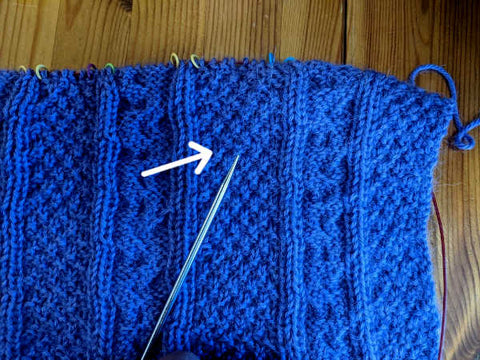Your Cart is Empty
Holiday Gift Sale! Shop Now > |Free USA Shipping On Orders Over $75!
Holiday Gift Sale! Shop Now > |Free USA Shipping On Orders Over $75!
Holiday Gift Sale! Shop Now > |Free USA Shipping On Orders Over $75!
Holiday Gift Sale! Shop Now > |Free USA Shipping On Orders Over $75!

by Kathleen Cubley June 25, 2020 2 min read
Joining a new yarn to your project can be a bummer if the join shows in the finished project. There are ways, however, to make the join invisible (or nearly so). Check out Kelley's join in her Jones Cardigan; if the needle weren't pointing to it you wouldn't be able to see it at all.

In our latest episode of Technique Tuesday, Kelley demonstrated four ways to join a new ball of yarn, and all of them work well when you're joining a ball of the same color yarn.
The first and most basic join is knitting a few stitches with the old yarn and the new yarn held together. Here's an example of that on my current project:

It's barely visible on the front; after blocking it'll be nearly impossible to see unless you really look for it. And who's going to do that?
For this join, you simply hold the tail of the working yarn together with the new yarn and knit two or three stitches. Then you drop the tail and continue with the new yarn, which is now your working yarn. It's important to hold the old and new yarns correctly or one strand of each double stitch will be seated backwards and it'll show in your finished object.
Make sure the end of your old yarn is to the right and the beginning of your new yarn is to the left, as shown below.

This join is my favorite. It only works on natural fibers, though, and I haven't been able to make it work well on superwash wool, so keep that in mind.
You don't have to use saliva to accomplish the spit splice, although many knitters swear it works better than water. In these days of Covid-19, we think warm water is your best bet.
Simply wet the end of your working yarn and the beginning of your new yarn and rub them together vigorously between your palms. You should feel quite a bit of heat in your hands, which is a sign that the wool has felted. Give it a little pull to make sure the join is secure. If it's not, re-wet the yarn and repeat the process.

This join is great for non-wool yarns. Basically, you loop the yarns around each other and use a tapestry needle to thread the end of each yarn into itself, securing the loop.

This is a method used a lot by crocheters. Because of the textural nature of most crochet stitches, the Magic Knot is hidden well in their work. I do know a lot of knitters who like this join, too, especially for lace-weight or fingering yarn. The magic part of the knot is that you can cut the tails off right at the knot and it won't come apart no matter how hard you pull.
I hope you'll take a look at Kelley's demonstrations of all of these methods for joining yarn. You're sure to find one that works for your project.
We'll see you see you next Tuesday at 9:30 am Pacific for Technique Tuesday!
Cheers,

Comments will be approved before showing up.

by Meg Bateman January 02, 2022 1 min read
Do you feel lost when it comes to picking out your first knit sweater pattern? This week, Kelley shared her favorite sweater patterns during Technique Tuesday. These patterns all feature minimal seaming, have detailed instructions, and have lots of completed projects on Ravelry!
Kelley has knit the Brick Sweater several times, and has decided to knit it again with all our Technique Tuesday viewers! Grab some worsted weight yarn and join us for this informal knit along.

by Meg Bateman January 02, 2022 1 min read

by Meg Bateman January 02, 2022 1 min read
Sign up to get the latest on sales, new releases and more …